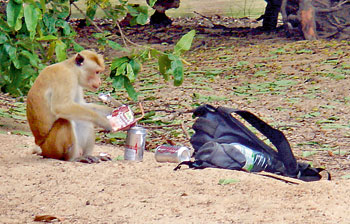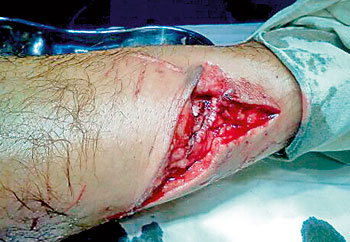Hard on the heels of the yet unsolved ‘grease yaka’ attacks, are reports of increased attacks by monkeys from several parts of the country.
The latest was at the Yala National Park when a French tourist was attacked by a monkey. The victim, Adrien Coulombel and his wife had stopped at a scenic spot near the river, where visitors are usually allowed to step out of their vehicles and have their meals if they wished to.
Adrien and his wife had alighted from their safari jeep to have some sandwiches when the attack occurred. He said there were some monkeys on the surrounding trees and they had walked away about 10 metres along with a couple of American tourists to observe a squirrel. When they walked back to their spot they saw a monkey eating their food. Amused at the scene that greeted them Adrien had clicked some photographs of the Toque Macaque in his act of daylight robbery. Alerted by human presence the monkey had scampered away pursued by Adrien who wanted to get a closeup picture.
 |
| Daylight robbery: Adrien’s picture of the curious monkey checking out their food and drinks |
“I didn't realize the danger and I shot the last picture on my knees – about 5 metres away from primate. I got frightened when I saw it baring its teeth and I stood up to beat a hasty retreat. It was then that I felt the razor like cut of a knife at the back of my left leg,” Adrian said recalling the incident The monkey had sunk its teeth just above Adrian’s ankle and the wound was so deep that it was bleeding profusely. Adrien was admitted to Hambanthota General Hospital. His wound was attended to under local anaesthesia and he remained in hospital for three days. The couple cut short their holiday and flew back home.
Unconfirmed reports said another tourist was attacked at the spot a week later.
Meanwhile primatologists blame the visitors to Yala and other sanctuaries for the aggressiveness of the monkeys. “This has been a location where Yala visitors are allowed to alight from their vehicles and have their meals leisurely. However, some visitors don’t clean up the remnants and some of them even feed the monkeys,” Dr.Woolfgang Dittus, well known for his study of toque monkeys in Sri Lanka said. The harmonious human-monkey relationship changes dramatically the moment humans start feeding monkeys. Monkeys can and do become aggressive towards people who feed them, he said.
He said many tour guides and vendors encourage tourists to feed monkeys to lure them closer for a good photo opportunity. The monkeys get the food, the tour guide gets the tip from the tourists for helping to get a photo, and the vendor gets the profit from selling his snacks. The tourist (or whoever feeds) takes the risk of being bitten, and the monkeys become pests and face the risk of being killed by people living in the vicinity, warned the expert.
Yala sources said that sometime back "pest monkeys" from the Hambanthota area have also been released into the Yala National Park. Dr.Dittus said the French tourist may have fallen victim to one of those "town monkeys" that had been translocated to the park
Translocation not a solution
Monkeys that raid properties and crops in towns or villages are lablled as pest monkeys. To curb this problem some have even resorted to killing these ‘pests’.. The most recent solution sanctioned by wildlife authorities is the capture and relocation of monkeys usually into a National Park in another area. Funds have been allocated to Divisional Secretaries to carryout relocation programmes.
Commenting on the problem of pest monkeys Dr.Dittus said, relocation was not an effective solution to the problem in the long run. He said it did not address the main causes of monkey overpopulation which were surplus of human food in the environment or monkeys invading villages due to fragmentation of their habitats. He said the void left by translocated or killed monkeys would soon be filled by monkeys from surrounding areas. Therefore translocation only provided temporary relief, he said.
 |
| The deep wound on Adrien’s leg |
He said translocating pest monkeys to a National Park or Sanctuary was futile because the useful habitat for monkeys in these natural areas are already filled to capacity with resident primates. These residents who live as troops will aggressively evict the newcomers from their territory.
In addition, pest monkeys are used to their ways, and they will not attempt to find food in the parks but raid villages at the periphery of the parks. Pest monkeys from the Badulla areas, for example, have been released into the Madura Oya Natioanl Park where these monkeys have become a nuisance to the local villagers.
There is also a scientific basis against releasing pest monkeys in a haphazard way. Sri Lanka has the highest diversity of primates in Asia, with five species and 12 or more subspecies. Three of these species occur only in Sri Lanka (endemic): the Toque Macaque (3 subspecies), Purple-Faced Langur (4-5 subspecies) and one of the two Loris species. Excepting the loris, all species could come into conflict with man, but the clever toque macaque is the easiest to tame and hence becomes a pest. The random translocation of monkeys is detrimental to the preservation of the genetic diversity because it undermines locality-specific evolutionary adaptations, say experts.
Wildlife Conservation Department (DWC) Director General, H.D.Ratnayake acknowledges that translocation is not the best solution. Monkeys are not a protected species by law, considering their potential to become a pest. “But we cannot kill the monkeys, therefore we opt for translocations. Mr.Ratnayake however assured that the monkeys are released deep in the jungles, so as to minimise penetration into nearby villages.
He urged the public not to feed the monkeys as they were unwittingly creating a problem. Countries like Malaysia and Singapore impose fines on those who feed monkeys at sanctuaries. In Singapore, the fine can be as much a $50,000 and six a month jail term. |



